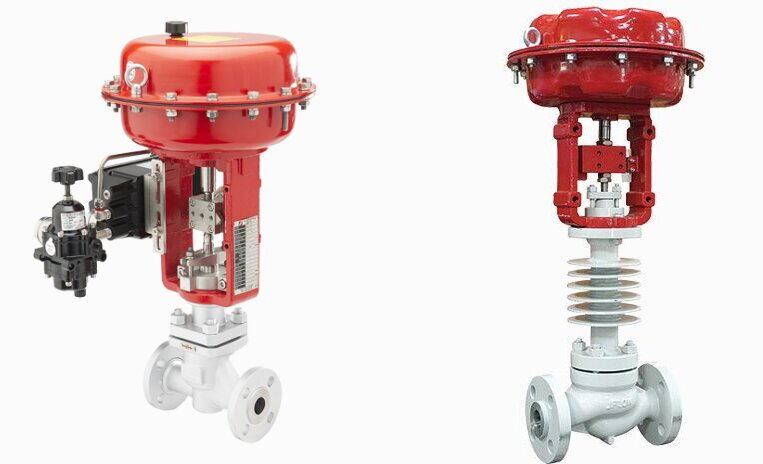
On this page
In various industries where fluid flow control is critical, single-seated globe control valves play a pivotal role. Engineered for precision, reliability, and durability, these valves are widely used in demanding applications like cooling water systems, fuel oil systems, and turbine lubrication. This article delves into the core features of single-seated globe control valves, the benefits of their top guiding structure, and the diverse applications where they excel.
Single-seated globe control valves are designed as non-balancing valves, which means they are well-suited for applications where pressure drops need careful control. Their top-guiding structure significantly reduces friction and minimizes disturbances, allowing for smooth fluid regulation. By ensuring precise guidance of the valve stem, this structure enhances overall stability, even in challenging operating conditions. One of the standout features of this valve type is the reinforced guiding area. This robust design ensures stable fluid control and minimizes vibration, a common issue in high-flow applications. The increased stability leads to better performance, reducing wear and tear and extending the lifespan of the valve. Maintenance is an essential aspect of any industrial valve, and the single-seated globe control valve is designed with ease of maintenance in mind. Its standardized, self-aligning stem guide allows for quick installation and disassembly without the need for special tools. This feature minimizes downtime and reduces maintenance costs, as the stem guide can be effortlessly aligned during reassembly. The integral structure of the plug and seat in single-seated globe control valves comes in two main designs: standard and severe-condition types. The severe-condition design is optimized for environments that demand low noise levels and effective cavitation control, ensuring that even under high-stress conditions, the valve maintains optimal performance. A simple replacement of the valve trim (cage) allows operators to adjust the valve to meet specific working conditions, making it highly adaptable to various industrial needs. Safety is paramount in fluid control systems, and the packing box of this valve is meticulously engineered for tight, multi-level sealing. This robust design meets stringent requirements for safe and reliable seals, preventing leaks and ensuring secure containment of various media. The secure sealing enhances the valve’s reliability, especially in critical applications where even minor leaks can lead to operational inefficiencies or safety risks. Single-seated globe control valves are versatile and adaptable, making them suitable for a wide range of applications. Here are some of the key areas where they are commonly used: In cooling water systems, maintaining precise control over water flow is essential for efficient heat exchange and system performance. Single-seated globe control valves offer reliable flow regulation, helping to maintain optimal temperatures in equipment such as heat exchangers and condensers. Their non-balancing design and low-friction guiding structure enable smooth operation even in varying flow conditions. Fuel oil systems require accurate flow control to maintain consistent fuel delivery and pressure, essential for safe and efficient combustion. Single-seated globe control valves provide this level of control, ensuring a steady flow of fuel oil to burners or other equipment. The valve’s ability to withstand high pressures and temperatures makes it an ideal choice for fuel oil applications, where precise control is paramount. In feedwater and chemical feed systems, valves must offer both precision and durability to control the flow of water or chemicals entering boilers, reactors, or other processing equipment. The single-seated globe control valve’s reinforced guiding structure and reliable sealing capabilities ensure that it performs well under the rigorous demands of chemical and feedwater applications. The ability to change valve trim to suit specific operating conditions also enhances its versatility in these applications. Control valves in boiler and steam systems must handle high temperatures and pressures while providing accurate control. Single-seated globe control valves are designed to meet these challenges, providing dependable control for steam vents, drains, and other critical points in boiler systems. The valve’s robust construction minimizes vibration and noise, contributing to a safer and quieter working environment. Turbine lubrication systems depend on precise control of oil flow to ensure the reliable performance of turbine components. Single-seated globe control valves offer the precise, stable control needed in these systems, helping maintain proper lubrication and cooling. The valve’s high-integrity sealing design also prevents leakage, protecting both the equipment and the fluid media. Single-seated globe control valves bring several advantages to industrial operations, particularly in applications where precise fluid control and durability are essential. Here are some key benefits:The reinforced guiding area in single-seated globe control valves ensures smooth operation with minimal vibration, even in high-flow applications. This stability translates to a longer valve life and reduced maintenance needs.
The severe-condition trim design in these valves reduces noise and prevents cavitation, making them suitable for high-pressure drop applications where these issues are common. Cavitation elimination also protects the valve from damage, extending its operational life.
The ease of replacing the valve cage (trim) to meet varying operational requirements makes single-seated globe control valves highly versatile, allowing them to be adjusted for different pressures, temperatures, and media.
With a multi-level packing box designed for stringent sealing, these valves provide a safe and reliable barrier against leaks. This feature is particularly crucial in systems where leaks can result in safety hazards or contamination.
The standardized self-aligning stem guide simplifies disassembly and reassembly, reducing maintenance time and costs. This ease of maintenance ensures that the valve can remain in optimal working condition with minimal disruption to operations.
Single-seated globe control valves are essential components in industries requiring precise and reliable fluid control. Their robust design, reinforced guiding structure, and adaptable plug and seat options make them well-suited to demanding applications. From cooling water and fuel oil systems to boiler and turbine lubrication applications, these valves provide stability, safety, and adaptability, ensuring smooth operations in even the most challenging environments. By understanding their key features and applications, operators can make informed choices to optimize system performance and reliability.